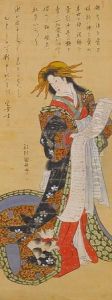Utagawa Kunitane Paintings
Utagawa Kunitane was a Japanese ukiyo-e artist known for his woodblock prints, particularly those depicting beautiful women, kabuki actors, and sumo wrestlers. Born in 1805 during the late Edo period, Kunitane was part of the Utagawa school, which was one of the most prominent and influential schools of Japanese art at the time. The school was founded by Utagawa Toyoharu but later came to be associated more with his student, Utagawa Toyokuni I, under whom the school flourished.
Kunitane, whose works were less prolific as compared to other Utagawa artists, still managed to contribute significantly to the ukiyo-e genre. His prints often reflected the cultural and social aspects of the Tokugawa era, capturing the hedonistic lifestyle of the urban populace as well as the popular entertainments of the day such as the theater and traditional sumo wrestling.
Throughout his career, Kunitane created images that were vivid and colorful, with an emphasis on elegant lines and a strong sense of design. His style was typical of the Utagawa school, characterized by the use of a wide range of colors and a focus on dramatic compositions. Like many ukiyo-e artists, he worked closely with woodblock carvers and printers to produce his prints, which were distributed to a broad audience.
Despite his contributions, Kunitane's work did not achieve the same level of fame as some of his contemporaries, such as Utagawa Hiroshige or Utagawa Kuniyoshi, and as a result, less is known about his personal life and training. He is believed to have been active as an artist from the 1820s to the 1860s, a period that witnessed significant political and social changes in Japan, including the end of the feudal system and the opening of the country to the West.
Kunitane passed away in 1868, coinciding with the Meiji Restoration, a time when Japan was undergoing rapid modernization and Westernization, which led to a decline in traditional woodblock printing. Despite this, his works remain a testament to the rich artistic tradition of the Edo period, offering insight into the cultural life of the time and the aesthetic values of the Utagawa school.
